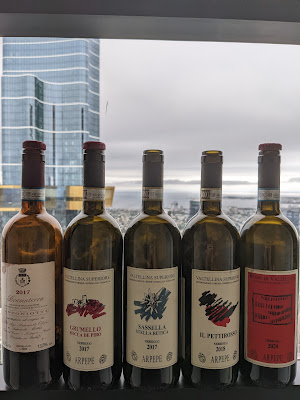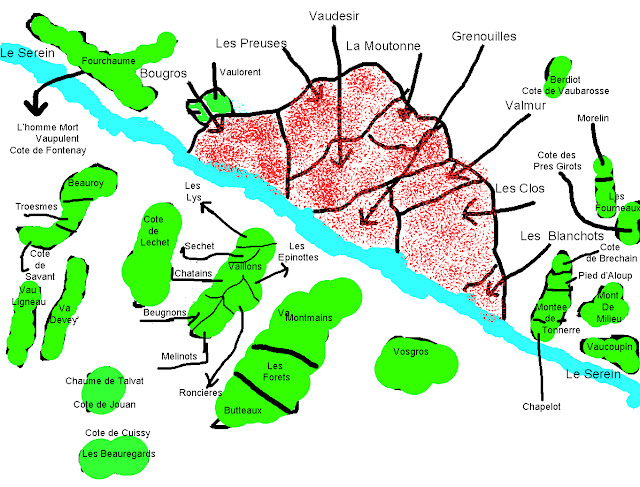Nebbiolo outside Langhe
Nebbiolo wines are perfumed with notes as "tar and roses"; with a moderate body; strong, tannic backbone; and high, fresh acidity. Nebbiolo is well-known for its relatively rapid transition from a violet-tinged ruby and purple color to brick-red and brick-orange hues in the glass. Rose petal, cherries, plums, violets, graphite, smoke, tar, mineral, and leather. A variety last to ripen, making it very susceptible to poor weather conditions in spring and autumn.
Nebbiolo synonyms:
Spanna, Picoutener, Chiavennasca.
Arpepe:
a family of winegrowers and, for over 150 years, we have been passionately devoted to the cultivation of Nebbiolo.
Situated in northern Lombardy at the foot of the Alps; an historic estate based in Valtellina in the very north of Italy, with an alpine twist. The Nebbiolo in Valtellina is known as Chiavennasca (after the nearby town of Chiavenna). Most Valtellina vineyards sit at altitudes between 230 and 765 meters.
The soils, typically alluvial: gravelly, well drained and rich in silica. They are littered with larger stones, which gather heat throughout the day and release it in the evening.
Valtellina Superiore wine is deep crimson in color, and has a rich bouquet of dried cherries, pencil shavings, tar and roses.
The vineyard area from which the wines may come is also more restricted than for standard Rosso di Valtellina. Only the finest sites, on sunny, free-draining, south-facing sites qualify. Most of these are located on the slopes above the five villages of Grumello, Inferno, Maroggia, Sassella and Valgella (the names of which may be officially added to the DOCG title on labels).
Valtellina Superiore wines must undergo 24 months of aging, of which at least 12 months must be in oak barrels.
To obtain the additional mention riserva they must be aged for a full three years. Aging has traditionally taken place in botti (large barrels) made from chestnut or Slavonian oak.
2020 Arpepe Rossso
Light to medium-bodied, on the nose oranges and herbs, strawberry and fresh raspberry, with a fine silky tannin and firm fresh acidity. Such vitality and freshness, plus taste. 90 days on skins, lots of flavour and elegance for an entry level wine. After fermentation, the wine matures 12 months in large barrels.
2017 Arpepe Grumello Rocco de Piro
Rocco de Piro is a 50 year old vines situated at 350 to 500 metres above sea level and the wine spends four months on skins in open tronconic wood vessel, before being pressed off to old chestnut botti to rest for 18 months. Grumello normally have more clay top soil on topf the substrate of granite underneath. Lots of red cherry intense note of oil mineral, nice structure support a beautiful spine acidity.
2017 Arpepe Sassella Stella Retica
Sassella is considered to have the finest vineyards, planted on incredibly steep slopes with a sunny southerly aspect. Located in a wider section of the valley where the peaks above do not obscure the sun until slightly later in the day, Sassella's vines have the advantage of added light and warmth, both vital resources in a sub-alpine environment. 550 meter above sea level, 5o years old vines in very rocky soil on the steppest terrace. Austere, minearl with .long life ahead.
Alto Piemonte Bramaterra along the Sesia river is another appelation dedicated to Nebbiolo, but the wines are always blended with various amounts of Croatina,Vespolina and Uva Rara. Volcanic porphyry soil, a kind of rich mineral granite.
The Antoniotti family has been making wine in their town of Casa del Bosco (Sostegno) in northern Piemonte for generations. Today Odilio, along with his son Mattia, work the vines and make the wines in the same traditional manner. Nebbiolo here is known locally as Spanna. On this cool climate style the tannins of Nebbiolo often fail to ripen completely, resulting silky and elegant.
2017 Antoniotti Bramaterra
Red fruit predominates, with some notes of herbs and a spicy, making for an elegant mineral nebbiolo silky and powerful on the same time. Lots of iron and blood orange notes give complexity and austerity on this wine. Ageing 36 months in big oak cask.
Carema:
A small mountainous wine-growing, very close to Valle D'Aosta region. Vineyards are on terrace very steep around 750m above sea level. Granite soil with feirly thin amount of topsoil. The wines must spend 36 months, of which 24 must be in wood, while the riserva must spend an extra six months in oak. Due to the cooler mountain climate the grapes don't ripen as well as those further south in Barolo and Barbaresco, so the wines tend to be less powerful, with slightly higher levels of acidity than those from the Langhe. However they are still full-bodied reds with earthy overtones, and lean towards a more aromatic and delicate style of wine.
Muraje is the project behind Federico and Deborah Santini whihc they have managed to collect about 1.5 hectares of vines spread over 35 to 40 different plots. Wonderful terraces form a real amphitheatre where uncontaminated nature dominates; soils of morainic origin, the vines are grown using the pergola system, called "topia" in Piedmontese dialect, whose framework of beams is often supported by the characteristic truncated conical stone braces, called "pilun", a true icon of the area.
2020 "Lasú" is a blend of 60% nebbiolo and 40% local grapes (neyret, ner d'ala). Very limited production, just 585 bottles, manual harvest in the second half of October, selection of berries and grapes directly in the vineyard, the alcoholic fermentation is spontaneous and carried out in steel tanks. Long macerations (end of December), once racked it is refined in a tonneau and a barrique, both exhausted, as well as a few demijohns. Spontaneous malolactic fermentation in the spring following the harvest, then racking into stainless steel until August, followed by bottling. No clarification or filtration, just a minimum of SO2.
Beautiful energy, high acidity and complex austere notes make this cuvee a truly gem.
2019 Muraje Sumiè
Carema DOC 100% Nebbiolo ageing in exhausted tonneaux for about 20 months
Lots of vivacity of the color, vibrant hue, between ruby and garnet with good consistency.
Sumiè, in dialect means the supporting pole of the Caremese pergola, this cuvee for Muraje is the birth of Carema, with the 2017 harvest and the first vinification on site. This 2019 is extremely good no words can justified the beauty of this wines.
Best
raffaele mastrovincenzo
--------------------------------------
wine / spirit / lambic / drinker
-------------------------------------
https://www.instagram.com/pitbeat/










Comments
Post a Comment